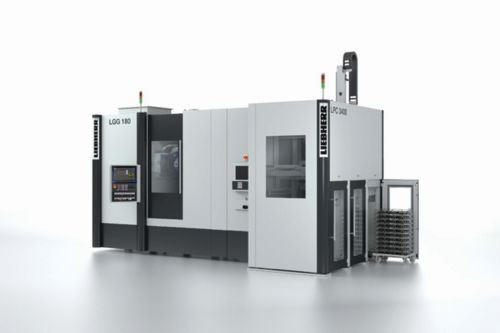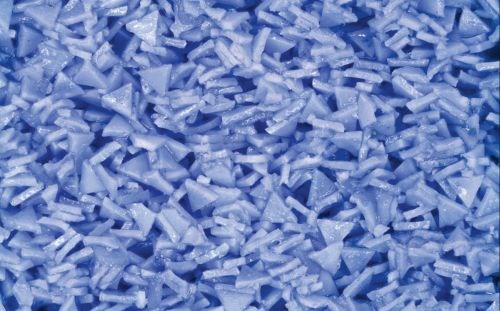Liebherr Group manufactures construction cranes, mobile cranes, crawler cranes, hydraulic excavators, wheel loaders, pipe layers, cargo handling cranes and stackers, aircraft landing gear, and refrigerators—just to name a few.
One of the things that the people at the company discovered shortly after it was founded in 1949 was that to produce many of its products, it needed gears. Rather than simply going out and sourcing the components, company founder Hans Liebherr and his colleagues decided in 1952 that they would build the machinery necessary to produce the gears they needed, which gave rise to another product offering: machine tools.
Today, Switzerland-based Liebherr is one of the world’s larger suppliers of hobbing and shaping machines, gear grinders and gear cutting tools. In addition, it has a range of robotic handling systems, which range in capacity from 0.5 to 1,500 kg.
While its mining excavators may be more massively impressive (for instance, engines ranging to 4,000 hp and shovel capacities to 42 m3), the gear-making machinery that Liebherr produces continues to be developed to keep up with internal and external customer demand. According to Scott Yoder, vice president of sales for Liebherr Gear Technology, one interesting result of its production of things like hydraulic excavators with service weights ranging to 810 tons is that the company produces the largest gear hobbing machines in the world, equipment capable of handling gears measuring 6,000 mm (almost 20 feet) in diameter.
This is certainly germane to people in construction and agricultural equipment manufacturing. That 6,000 mm is longer than a Rolls-Royce Ghost Extended Wheelbase (5,569 mm)—the entire car is smaller than a single gear.
But we’re interested in learning about developments related to producing gears of a more modest size, such as the LC 180 hobbing machine, which is capable of producing gears ranging to 180 mm in diameter, and the LGG 180, a generating and profile grinding machine with the same capacity.
Those familiar with Liebherr will recall that the company has been offering chamfer cut capability since 2005. This process was developed along with German tool manufacturer LMT Fette as an alternative to milling or forming chamfers on the front ends of gear teeth. Chamfering is gaining importance nowadays, particularly for gears used in automotive transmissions. Given that the gears are on the order of 12 mm in diameter, it is important that there is consistency in the size of the chamfer,
as a difference between 0.5 and 1 mm is enormous. What’s more, throughput time is critical given the production volumes necessary to address the increasing number of gears in automatic transmissions.
In the previous approach to chamfer cutting, the hobbing and chamfering tools were mounted on a single arbor. So after the gear was hobbed, it was then addressed by two tools, with the first deburring and chamfering the top surface and the second doing the same to the bottom surface.
While that addressed the issue of precise and reproducible chamfers, there was an issue of cycle time: Given that all of the tools were on one arbor, it was necessary to complete the entire sequence before beginning the hobbing of another gear. “We have solved this by integrating a complete second machining unit for chamfer cut tools—two machines in one, so to speak,” says Dr.-Ing. Oliver Winkel, Liebherr-Verzahntecnik director of application technology.
So in the LC 180 hobbing machine, there is a separate area for the chamfering. This means that after part A has been hobbed, it is indexed to the chamfer cut station and part B is loaded into the hobbing station. While part A is undergoing chamfering, part B is being hobbed. “This innovation enables the machine to combine an already undisputed high chamfering quality, provided by the proven chamfer cut procedure, with cycle times that correspond to the demands of the automotive industry,” says Dr.-Ing. Winkel.
Another benefit of this approach is that because the chamfer tool is separate from the hobbing tool, the length of the hobbing tool can be maximized and the size of the chamfering tool can be reduced to produce the small, precise chamfers necessary in automatic transmissions.
However, it wasn’t simply a matter of Liebherr’s machine designers saying, “Well, we are doing two operations separately, so let’s double the size of the machine to do both.” Rather, explains
Dr.-Ing. Hansjörg Geiser, manager of development and design for gear cutting machines at Liebherr, “The main design engineering challenge was to execute the chamfer cut unit at a reasonable cost.” So they maintained the size of the machine that would be necessary if the single-tool approach were used, but incorporated a four-station ring-loader concept. Chamfering is done at the 90-degree position in the ring loader.
For those who are looking to grind gears, the company has developed the LGG 180 and the LGG 280 machines, with the latter accommodating gear diameters ranging to 280 mm, but both machines having the same exterior dimensions. Explaining this approach, Dr.-Ing. Andreas Mehr, Liebherr grinding and shaping technology development and consultancy, says, “Vehicle manufacturers can thus develop a complete production line, in which all gearing components for a passenger vehicle transmission can be ground: planetary gears, sun gears and bore-type gears, as well as drive and pinion shafts with lengths ranging to 500 mm.”
It is also worth noting that they’ve taken a one-table approach. “Choosing a one-table solution means one setting, one geometry,” Dr.-Ing. Mehr says. “A key argument in favor of the one-table solution is the statistical capability and reliability in continuously producing controlled micro-range finish quality.”
The machine has a grinding head that operates at speeds ranging to 10,000 rpm and has spindle power of 35 kW. These parameters make the LGG machines capable of using 3M’s Cubitron II abrasive, which Mr. Yoder says is one of the most significant developments in grinding technology in quite some time, in that it provides the means to greatly reduce the costs in gear grinding due to the “precision shaped grains” that are the abrasive of the tool.
While the ceramic abrasives in typical grinding worms have undefined shapes, those used in the Cubitron II grinding worms have triangular shapes. What’s more, when the triangles wear, they do so in such a way that there are still sharp points. This isn’t a matter of plowing through metal with the undefined shapes that tend to load. The triangles are freer cutting, which also means consistent grinding and a reduced chance of burning.
In tests, 3M has shown that compared with conventional ceramic abrasives, the Cubitron II abrasive allows a significantly higher feed rate, which results in an improvement in cycle time of as much as 50 percent or more in various gear grinding applications.




.jpg;width=70;height=70;mode=crop)



















